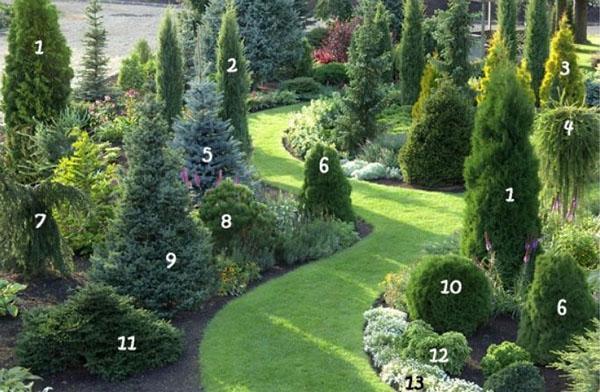Gourmet conifers: collecting a collection for the garden
 When the forests shed their crimson outfits, they are replaced by exquisite conifers. They do not change color even with the onset of winter. The diversity of the genus surprises with the variations of its species. There are giants and dwarfs, deciduous and groundcover, with a spreading, pyramidal or spherical crown. Therefore, not using them on your site is simply sacrilege.
When the forests shed their crimson outfits, they are replaced by exquisite conifers. They do not change color even with the onset of winter. The diversity of the genus surprises with the variations of its species. There are giants and dwarfs, deciduous and groundcover, with a spreading, pyramidal or spherical crown. Therefore, not using them on your site is simply sacrilege.
Read also the article:breadfruit - where does it grow and why is it called?
Slender thuja
The culture belongs to the Cypress family. Includes 6 species that are common in East Asia and North America. It is used as:
- low curbs (dwarf varieties);
- decorations of reservoirs;
- hedgeif you cut the branches, then they begin to grow in breadth;
- plantings along alleys (tall and columnar varieties);
- group landings.
Feature of the species: flat shoots with scaly needles. Adequate lighting, fertile soil and abundant watering (at a young age) contribute to the successful development of thuja.
Metasequoia will help surprise guests with its exotic and majestic look. It is considered a museum piece. Requires a lot of space around him: home, golf course or huge lawn.
Gourmet conifers in composition
Fir (from the Pine family) perfectly tolerates severe frosts and drought. Her crown resembles a royal fur coat made of green needles. Upward protruding buds distinguish the culture from other species. She dies in smoky and gassed areas. Unique:
- trunk height - up to 60 m;
- perfect crown that does not need to be formed;
- medicinal properties, because healing ethers and decoctions are made from bark and needles.
Gardeners love juniper... In nature, both thorny and deciduous specimens are found. Its evergreen branches purify the air from pathogenic microbes. The fruits of the plant are used for:
- stimulation of appetite;
- diuretic effect;
- creating a fragrant atmosphere.
There are varieties of these exquisite conifers of various shapes: creeping horizontal shrubs, as well as columnar trees. However, the juniper is afraid of sunburn. Therefore, they hide him. Find out what sequoia height!
Freedom-loving larch
The idol of the alleys / parks is the luxurious larch. It successfully resists storms, winds, frosts and droughts. However, for its prosperous existence, you will need a lot of free space, since the tree grows up to 60 meters. It should be borne in mind that this species belongs to deciduous, therefore, its needles turn yellow and fall off in the fall.
Yew was created for optimists and daredevils. All its parts are poisonous, but malleable for cutting, which allows you to make beautiful figures from the crown. The seedling grows very slowly. The culture is considered to be dying out.
All adored sisters - spruce and pine
The straight trunk with a dense conical crown perfectly appeals to designers. About 40 species of spruce are known, which differ in size and color. Although it is shade-tolerant, as well as winter-hardy, it still cannot withstand:
- smoke and exhaust gases;
- dry air;
- early fall / spring frost (when young shoots develop, which are most often affected by this).
Pine is called ubiquitous as it grows from Spain to the Pacific Ocean. The tree is very tall, but when grown properly, it can control its growth.
Coniferous varieties are very capricious when choosing "neighbors". Cedar and pine do not get along with spruce, as well as fir. Larch is a famous loner. Thuja hates the company of eating. Many problems can be avoided by applying these rules.